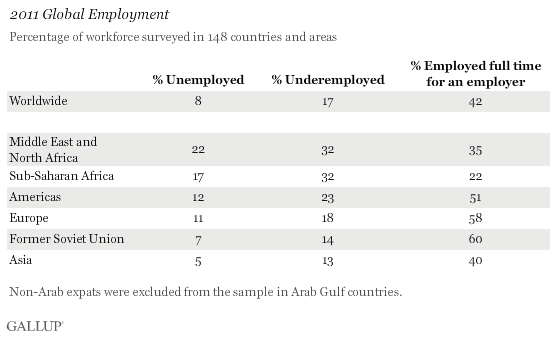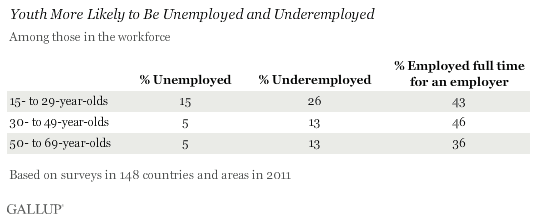WASHINGTON, D.C. -- Global unemployment remained stable at 8% between 2010 and 2011, according to Gallup surveys in 148 countries. Unemployment was highest in the Middle East and North Africa (22%) and sub-Saharan Africa (17%) last year and lowest in Asia (5%).

Countries and territories such as South Africa, Botswana, Swaziland, Iran, Iraq, and the Palestinian Territories -- all of which have among the highest unemployment rates in the world -- largely drive the high unemployment rates in the Middle East and North Africa and sub-Saharan Africa regions. Global employment data are available in Gallup's State of the Global Workplace report.
Gallup collects employment data using identical questions worldwide to classify respondents' employment status. Unemployed people are looking for work and available for work. The underemployed are either unemployed or employed part time but wanting to work full time -- this is a more complete measure than an unemployment measure is of the number of people who need more work.
Seventeen percent of the world's workforce was underemployed in 2011, a slight decline from 18% in 2010. As with unemployment, underemployment rates are highest in sub-Saharan Africa (32%) and the Middle East and North Africa (32%), and lowest in Asia (13%).
Forty-two percent of adults globally were employed full time for an employer, Gallup's measure of "good jobs." Half as many in sub-Saharan Africa (22%) were working full-time for an employer. Full-time employment for an employer has been linked to greater GDP per capita and improved well-being.
Youth Three Times as Likely to Be Unemployed
Young people between the ages of 15 and 29 are three times more likely than their older counterparts to be unemployed. Fifteen percent of 15- to 29-year-olds are unemployed, compared with 5% of 30- to 49-year-olds and 5% of 50- to 69-year-olds. Young people are also twice as likely to be underemployed. On a positive note for young people, they are more likely than 50- to 69-year-olds to be working for an employer. The data suggest that while youth are struggling with unemployment, those who are working are more likely than older people to have good jobs.

Implications
Gallup's regional employment numbers highlight the importance of monitoring a well-rounded set of employment indicators, rather than focusing exclusively on unemployment, which does not always paint a complete picture of worldwide employment. Sub-Saharan Africa has one of the highest unemployment and underemployment rates and the lowest good jobs rates in the world. These data underscore the desperate need for quality employment opportunities and business growth in the region. Asia has the lowest unemployment rate in the world, but also has relatively few people working in full-time jobs for an employer. Low unemployment rates, such as those in Asia, can mask high rates of subsistence jobs. Such jobs count as employment, but they do little to contribute to the economic well-being of individuals and countries. Underlying these numbers is a need for better job opportunities.
Survey Methods
Results are based on telephone and face-to-face interviews with 187,119 adults, aged 15 and older, conducted in 2011 in 148 countries. For results based on the total global sample, one can say with 95% confidence that the maximum margin of sampling error is less than ±1 percentage point. For results based on regional samples, the margin of error ranges from ±1.1 percentage points in the former Soviet Union to less than ±1 percentage point in Asia. The margin of error reflects the influence of data weighting. In addition to sampling error, question wording and practical difficulties in conducting surveys can introduce error or bias into the findings of public opinion polls.
For more complete methodology and specific survey dates, please review Gallup's Country Data Set details.
